Theodoric the Great › The Saxons » Ancient origins
Articles and Definitions › Contents
- Theodoric the Great › Who Was
- The Saxons › Antique Origins
Ancient civilizations › Historical and archaeological sites
Theodoric the Great › Who Was
Definition and Origins
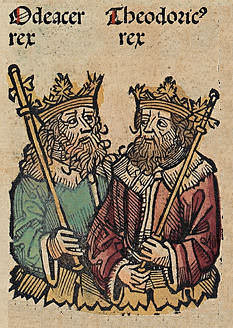
Theodoric (known as Theodoric the Great and Flavius Theodoricus, 451 or 454 - 526 CE) was the king of the Ostrogoths who, at the encouragement and direction of the Roman emperor Zeno, invaded Italy, deposed King Odoacer, and ruled over a kingdom of Romans and Goths from 493-526 CE. He was originally named Dietrich (or Diederich) and passed into German legends under the name Dietrich von Bern, the hero of many tales in Middle High German literature (though this identification has been challenged by a number of scholars on the subject). He was an Arian Christian, and his tolerance for Trinitarian Christianity in spite of the tension between the two groups, as well as his careful policies regarding the rights of his subjects, made him an effective ruler until his later years. Increasingly surrounded by enemies, he began to suffer from acute paranoia and engaged in persecutions of high-ranking Trinitarians at his court, such as the philosopher Boethius and Boethius' father-in-law Symmachus. His mausoleum at Ravenna still stands in the present day, and he is remembered as a sympathetic, wise, and just ruler.
EARLY LIFE & RISE TO POWER
Theodoric was born c. 454 CE, the son of King Thiudimir of the Ostrogoths and one of his concubines. He was baptized as Dietrich but, at the age of eight, was sent to Constantinople, seat of the Eastern Roman Empire, as a hostage to guarantee his father's compliance with a treaty between the Romans and the Goths, and his name was romanized to "Theodoric". He remained at court, becoming educated in Graeco- Roman values, for ten years under the protection of the emperor Leo I(reigned 457-474 CE) and then the emperor Zeno (reigned 474-475 CE, 476-491 CE). He never learned to read or write but adopted Roman cultural norms and was later described by the scribe Sidonius Apollinaris as highly refined in both his private and public life.
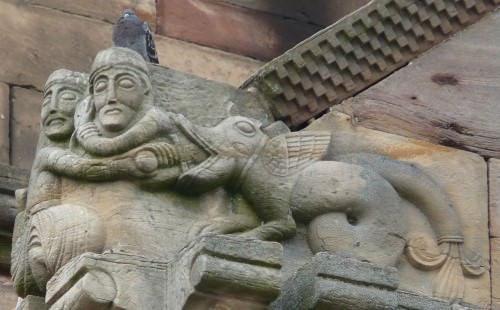
Epic of Dietrich von Bern, Sintram, and the Dragon
According to Jordanes (6th century CE) he was of the Amal family who had ruled over the Goths since ancient times and were of royal blood (though this claim, like much of Jordanes' work, has been challenged). He was an avid hunter and an excellent shot with the bow. Further, he seems to have shown an early talent for commanding men. He was made Master of Soldiers under Zeno in 483 CE and, a year later, was elected Consul and given the name Flavius Theodoricus. These rewards were given for his service to the empire in keeping at bay another Ostrogothic leader named Theodoric Strabo ("the Squinter") who harassed the empire when he was not fighting for its cause. Both Theodoric the Amal and Theodoric Strabo were considered kings of their respective factions of Goths and vied with each other for the greater favor of the empire while, alternately, turning and ravaging the empire's lands when they felt they were not being accorded enough respect or employment in arms. The historian Guy Halsall writes:
Between 474 and 488 a complex merry-go-round of alliances, treachery, murder and intrigue constantly shifted the balance of power. The emperor sometimes needed Gothic support against other factions, but could not allow them to become too powerful. The Emperor Zeno, himself Isaurian but faced with rebellions by his own people, who wished to dominate the Constantinopolitan court, played the two Theodorics off against each other with some skill until in 483-484 he overplayed his hand. Strabo was killed in an accident, falling from his horse onto a spear, and in the aftermath Zeno encouraged Theodoric the Amal (whom he rewarded with considerable honours, including the consulate) to murder the Squinter's son Recitach. Rather than removing one of the problematic factions, however, this simply led to Recitach's Goths joining the Amal…Instead of two competing Gothic groups, Zeno was confronted by one large and very powerful force (286-287).
THE ITALIAN CAMPAIGN
Following the death of Recitach and the consolidation of the Gothic forces under his lead, Theodoric was sent by Zeno against his rival General Illus, who had raised a revolt among the Isaurians in Asia Minor. Once he had defeated Illus and put down the revolt, Theodoric marched his army back toward Constantinople. Having defeated both his Gothic rivals and the Isaurians, he was now the most powerful military leader in the region and decided to take from Zeno what he felt he deserved but had not been offered: an allotment of land for his people and official recognition as their king. He began a systematic campaign against the empire and the emperor who had brought him to power. Having been raised at the court, Theodoric understood well how military might translated to political power and raided those cities and villages that he had formerly protected. Halsall writes,
the Goths threatened Constantinople and ravaged the Balkans but could not take the capital, whilst Zeno, secure behind the city 's famous triple line of walls, was unlikely to drive the latter completely from his territories. A solution was required, agreeable to both parties, and found: for Theodoric's Ostrogoths to move to Italy and dispose of the "tyrant" Odoacer. In 488 the Ostrogoths took the long road west (287).
Whether the invasion of Italy was initially proposed by Zeno or Theodoric has been disputed but, most likely, it was Zeno's solution to two pressing problems.
ALTHOUGH THEODORIC COULD NOT READ OR WRITE, HE WAS A GREAT PATRON OF EDUCATION, ENJOYED PHILOSOPHICAL DISCUSSIONS & ENCOURAGED LITERACY AMONG THE PEOPLE.
Odoacer (433-493 CE) had been king of Italy, with Zeno's permission, since 476 CE but had increasingly been causing problems for Zeno. Odoacer had backed Illus' revolt, had annexed the region of Dalmatia with impunity, and was acting more like an independent monarch of a country than the ruler of a Roman province. Zeno needed to rid himself of Odoacer and Theodoric both, and it is thought that he considered this solution the best, as one of them was certain to kill the other and he would then have only a single problem to deal with.
Theodoric, for his part, seized on the opportunity for further military glory and, if he won, a land for his people and his own legitimate rule. He invaded Italy, ravaging the land, and encountered his first resistance from the Gepid people at the Vuka River in 488 CE. It is unknown whether they were allied with Odoacer or simply protecting their lands from invasion, but they were quickly defeated and slaughtered by Theodoric's forces. Theodoric marched on and met Odoacer's forces in battle at the Isonzo Bridge 28 August 489 CE, where Odoacer was defeated. He retreated to Verona with Theodoric in pursuit and they clashed again on 29 September 489 CE; Odoacer was again defeated. He then fled to Ravenna and prepared the city's defenses, while Theodoric continued his conquest of the country. The historian Herwig Wolfram writes:
Theodoric's march to Italy seemed destined for a fast and decisive victory. In Milan, which Theodoric captured after Verona, secular and ecclesiastical dignitaries welcomed him as the emperor's representative. Even Odovacar's commander-in-chief, Tufa, and large numbers of the defeated army joined the victor (281).
Trusting Tufa's gesture of submission and allegiance, Theodoric sent him in command of his elite troops to Ravenna to capture Odoacer. Tufa had only been feigning loyalty to the conqueror, however, and betrayed the troops to Odoacer's soldiers; the elite force was destroyed, and "Theodoric suffered his first serious defeat on Italian soil" (Wolfram, 281). Odovacar left Ravenna and took the battle to the enemy who repeatedly repelled him. Tufa met Frederick of the Rugii in battle in August of 491 CE and both were killed. Hostilities continued until 25 February 493 CE, at which time John, the bishop of Ravenna, brokered a treaty by which Odoacer and Theodoric would rule jointly. Theodoric rode into Ravenna 5 March 493 CE and, on 15 March, at a formal dinner held to celebrate the treaty, Theodoric murdered Odoacer by stabbing him to death. Odoacer's last words were, "Where is God?" to which Theodoric replied, "This is what you have done to my people" in reference to his supposed oppression of the Goths in Italy and his decimation of the Rugii tribe, who were related to the Goths. Wolfram describes the aftermath of Odoacer's death:
The deliberate and methodical nature of Theodoric's act is clearly revealed by the subsequent events: Odovacar was not allowed to receive a Christian burial and his wife Sunigilda was starved to death. Odovacar's brother Hunulf sought refuge in a church and was used as a target by Gothic archers...On the day of Odovacar's murder his followers and their families were attacked. Wherever the Goths could lay hands on them they met their deaths. In the course of the year 493 Theodoric had become the unchallenged master of Italy (284).
Odoacer had ruled Italy prudently, and Theodoric inherited a kingdom of substantial wealth. The land had been destroyed by years of war, however, and so Theodoric's first priority was restoration.
THEODORIC'S EARLY REIGN & LEGITIMIZATION
Theodoric set about consolidating his rule while repairing the country, which had been devastated between 488-493 CE. Many of the forests had been destroyed, either decimated in battle or cut down for defense, and with no trees to absorb rain water, a number of regions were regularly flooding while others, stripped of their top soil by battle, were arid. Theodoric had swamps drained, trees planted, and was able to employ expert well-borers to drill wells, create irrigation ditches, and cultivate the land.
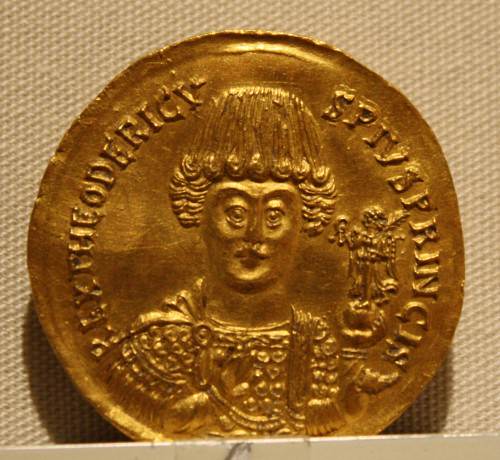
Theodoric
He ruled over a diverse populace of Goths and Romans and issued edicts to ensure fair representation before the law. Further, the country was divided along religious lines with most Romans adhering to Trinitarian Christianity and most Goths following the Arian understanding of Christianity. Theodoric, himself an Arian, mandated tolerance of religious differences and hoped to unite his kingdom completely under his rule, no matter his subject's nationality or religious beliefs. To this end, it is thought, he needed to legitimize his past and create for himself and his people a pedigree worthy of a king who would be respected by both Goths and Romans.
The primary source on the history of the Goths is Jordanes' Getica from the 6th century, which was written as a synopsis of the earlier work of Cassiodorus (c. 485-c.585 CE), Theodoric's Master of Offices and, therefore, chief scribe. Cassiodorus was a Roman and so imbued his history of the Goths with Roman ideals and a narrative that would appeal to a Roman audience (as Jordanes also would do later). The historian Roger Collins writes:
Interest in establishing continuity in a royal line was far more the product of Roman presuppositions about the working of Germanic societies that it was something of interest to those societies themselves. In the first half of the sixth century, the Ostrogothic regime in Italy needed a history and a constitutional role for itself that fitted in with the intellectual expectations of the Roman upper classes upon whose goodwill and co-operation it largely depended, and who also liked to imagine great family continuities between themselves and the aristocracies of the Republic and Early Empire (104-105).
The Gothic history of Cassiodorus (now lost) is believed to have taken some genuine aspects of the history of the Goths and framed them in traditional Roman narrative form, adding those elements the writer thought desirable, in order to create a noble history of the ruling party in Italy. It has been noted that Jordanes himself writes that he "made the Origin of the Goths into Roman History" and, as he was following Cassiodorus' lead, the former is thought to have done so also. What impact the work of Cassiodorus had on the populace in general is not fully known but it raised Theodoric's stature among the elite and, whether he was a member of the Amal family (and whether that family had actually accomplished what Cassiodorus' work claimed), he was now considered a legitimate Roman ruler instead of a barbarian king. Zeno was dead by the time Theodoric assassinated Odoacer and Anastatius I was emperor. In 497 CE Anastatius I officially recognized Theodoric as King of the Goths and the Romans.
POLICIES & PROGRAMS
Although legitimized on paper, and now formally recognized by the Roman Empire, Theodoric understood he needed more than this to establish himself securely on the throne. He had sent one of his daughters, Theodegotha, to be married to King Alaric II of the Visigoths in c. 494 CE and another daughter, Ostrogotha, as wife to Sigismund of the Burgundians in 496 CE.He himself had married Autofleda, sister of King Clovis I of the Franks, shortly after his victory over Odoacer in 493 CE. By these alliances he hoped to form a kingdom in which all the former peoples known to the Romans as "barbarian tribes" could live together peacefully. The Catholic Encyclopedia comments on this, stating:
Proud of his Gothic nationality, Theodoric believed it possible to reconcile Roman and Germanic interests. His people seemed to him equal to the Romans in antiquity of descent and military renown, and he realized that his power rested solely on Gothic prowess. Apparently his kingdom was a continuation of the Roman Empire; in reality his policy was in direct and fundamental contradiction to the Roman conception, by which all national individuality was to be lost in the State as a whole. This theory of government which sought to suppress nationalities was opposed by Theodoric; he had a profound respect for national independence, and had repeatedly taken up arms to maintain it (1).
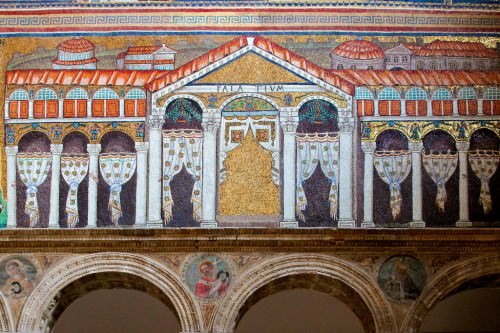
Palace of Theodoric Mosaic
His court included men of all nationalities and, like Odoacer before him, he worked diligently to keep peace among his subjects by not favoring his own people above others. The Edictum Theodorici of 512 CE reformed his earlier laws to make it clear that everyone in his kingdom had access to the same rights under the law, in this case, criminal law. Although he could not read or write, he was a great patron of education and enjoyed philosophical discussions. He encouraged literacy among the people and kept at his court the philosopher Boethius (480-524 CE). He provided regular entertainment for his subjects in the revival of the circus spectacles of Rome and initiated a program by which the poor received free supplies of corn. He also employed a significant proportion of the population in his building programs, and Collins writes, "Theodoric's programme of new buildings and the restoration of existing ones was far more extensive [than Odoacer's) and included the creation or repair of aqueducts, pubic baths, city walls and palaces - the latter being centres of administration rather than private residences - in a variety of cities, including Rome, Ravenna, Verona and Pavia" (108). His policies regarding religious tolerance also encouraged peace among his subjects and provided the understanding that every religious belief was of equal value, while his diplomatic skills ensured peace with his neighboring kingdoms.
THEODORIC'S DECLINE & DEATH
Even with all of these successes, he still suffered challenges and setbacks. In 507 CE Clovis I defeated Theodoric's ally, Alaric II, and killed him, and the Franks then refused to intervene when the Burgundians, who should also have been allies, began incursions against Italy on the coast. Theodoric sent his forces against the Burgundians and secured his kingdom, while also enlarging his territories, by 513 CE. He continually juggled his supposed allies in attempts to keep the peace while also recognizing the importance of satisfying Rome in the east. Among his other concerns was his inability to produce a male heir to succeed him, which he knew he would need in order for his dynasty to be recognized by the Roman authorities.
Unable to produce this heir, he named his grandson Athalaric his successor. Athalaric was the son of Theodoric's daughter Amalasuntha and the Visigothic prince Eutharic. Eutharic died early in the marriage,and Amalasuntha remained a widow, so the young prince Athalaric was the only choice left but, more importantly, by naming him heir, Theodoric brought the Visigothic Kingdom under his rule, in that their prince was now heir to his throne.
Feeling more secure in his rule, Theodoric now seemed to change in both his private and public political life. Halsall writes, "He increasingly adopted a quasi-imperial style. Theodoric had not been above this type of posturing earlier in his reign but it became more noticeable in the latter stages, and associated with a change in ideology" (290). Part of this change in ideology was a stricter adherence to his own Arianism at the expense of Trinitarians. The emperor Anastatius I had died in 518 CE and was succeeded first by Justin I (reigned 518-527 CE) and then by his young nephew Justinian I (reigned 527-565 CE). Under Justin's rule, Justinian played an active role in policy and among these policies was a persecution of Arian Christians in Constantinople. Justinian I was a Trinitarian and considered Arianism a heresy and a danger to the "true church". In response, Theodoric began his own persecution of Trinitarians in Italy which, of course, led to tensions between his kingdom and Constantinople. In the year 523 CE, the ex-consul Albinus was charged with treason for alleged correspondence with the emperor Justin. The philosopher Boethius came to his defense and was also charged and later executed; his father-in-law Symmachus soon followed him. The purge of Trinitarian Catholics would have no doubt accelerated but Theodoric's health began to fail and he died in 526 CE after 30 years as king.
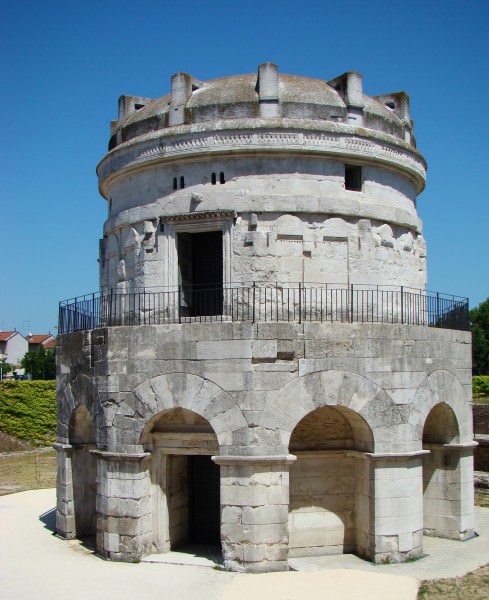
Mausoleum of Theodoric, Ravenna
AFTERMATH & LEGACY
Following his death, his grandson Athalaric succeeded him but, as he was only ten years old at the time, could not rule and so Theodoric's daughter Amalasuntha took the throne as regent. She was an advocate of Roman sensibilities and culture and entrusted her son to Roman tutors who took advantage of their position to introduce the prince to heavy drinking which is said to have contributed to his early death in 534 CE. Amalasuntha had already opened negotiations with Justinian I in Constantinople to try to help secure her position but received no adequate response. She therefore called upon a trusted male cousin, Theodahad, to rule jointly with her and he came willingly. Amalasuntha then was arrested and exiled to an estate on the island of Martana where, under the orders of Theodahad, she was strangled by her servants in her bath in 535 CE. Her son-in-law, Witigis (also known as Vitiges), then rose against Theodahad, had him assassinated, and became king in 536 CE.He ruled over Italy until his defeat and imprisonment by Belisarius in 540 CE. Following Belisarius' victory over Witigis, the Goths wished to crown him their new king but he, loyal to the emperor Justinian I, tricked the ring-leaders by pretending to accept and then had them all arrested. Belisarius then claimed the whole of Italy for Justinian I and the eastern Roman Empire.
Although Theodoric could not sustain his policies of religious tolerance nor his diplomatic expertise in dealing with Constantinople, he is still remembered as `the great' for his attempt to unify the populace under his reign into a single people and for, essentially, re-building Italy whether by planting trees, cultivating fields, constructing new buildings, or keeping hostile forces at bay. His vision of a kingdom of unified, though independent, nationalities living harmoniously under one rule was revolutionary for its time. Even Alexander the Great, who, for the most part, allowed conquered regions to maintain some degree of autonomy as long as they supported his cause, did not encourage the kind of independent national pride the people under Theodoric were allowed. For thirty years Theodoric united the Goths and the Romans under his reign, maintained the peace, and worked for the well-being of his kingdom, raising Italy from ruin to stability and then to prosperity and even luxury.
He was buried with full honors in his mausoleum at Ravenna and, although this was later desecrated following Belisarius' victory over the Goths in 540 CE, it was repaired and still stands in the city in the present day. Theodoric is remembered as `the Great' for his revitalization of Italy and his efforts in ruling over a diverse population without attempting to assimilate either culture into the other. His legacy continues into the present day as a great king who ruled his people wisely with the vision of a united kingdom of separate but equal populations. His later persecution of Trinitarian Christians is attributed to his emotional response to Justinian's anti-Arian policies in Constantinople rather than a clearly considered policy of discrimination and his memory continues to be honored for the vision he maintained and his efforts to make it a reality.
The Saxons › Antique Origins
Definition and Origins
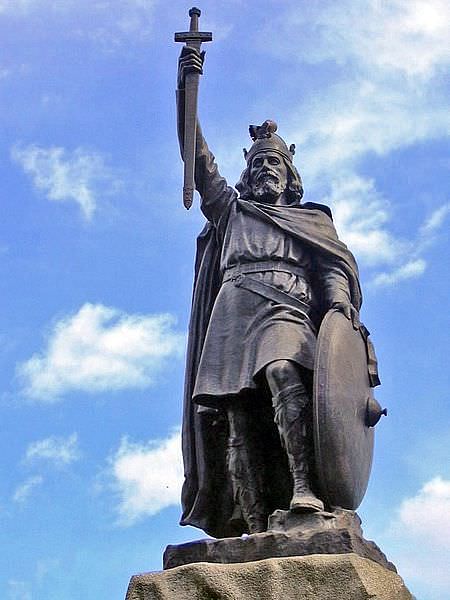
The Saxons were a Germanic tribe that originally occupied the region which today is the North Sea coast of the Netherlands, Germany, and Denmark. Their name is derived from the seax, a distinct knife popularly used by the tribe. One of the earliest historical records of this group that we know of comes from Roman writers dealing with the many troubles that affected the northern frontier of the Roman Empire during the second and third century CE. It is possible that under the "Saxons" label, these early Roman accounts also included other neighbouring Germanic groups in the regions such as the Angles, the Frisians, and the Jutes; all these groups spoke closely related West Germanic languages that in time would evolve into Old English.
Since the Saxons were illiterate, most of what we know about them comes from reports of a handful of writers (mostly bishops and monks) and also from archaeological research. The Saxons were among the "barbarian" nations that would engage against Rome during late antiquity, putting an end to the dying imperial order in the western realm of Rome, reshaping the map, and renaming the nations of Europe.
EARLY HISTORY
South of the territory where the Saxons lived on the continent were the Franks, a strong Germanic confederacy that had a solid presence occupying a territory between the Saxons and the Roman frontier. For this reason, expanding southwards was a problematic option for the Saxons, and a sea expansion was a more suitable alternative. Late in the third century CE, Frankish raiders joined the Saxons in the southern part of the North Sea and the English Channel. They preyed on shipping lanes and also raided the coast of Britain and Gaul. These attacks on Roman Britain during the late third century CE forced the authorities to build a network of forts with thick stone walls at coastal locations to repel these attacks, and the south coast of England became known as the Saxon Shore frontier. Generally located next to important harbours and river mouths, these forts not only served as strategic defences against the raiders, but also as a means of securing the collection and distribution of state supplies.
Carausius, a Menapian commander of Roman legions under the future emperor Maximian, was given the task of eliminating the Frankish and Saxon pirates in 285 CE. His mission was very successful and, by 286 CE, he had broken the pirate's power at sea. He was accused, however, of being in league with the pirates and keeping their plunder for himself and so was condemned to death by order of Maximian (who was then emperor of Rome). Rather than submit to what he saw as unjust charges, he declared himself emperor of an independent Britain and reigned until 293 CE, when he was killed in battle and rule from Rome was restored.
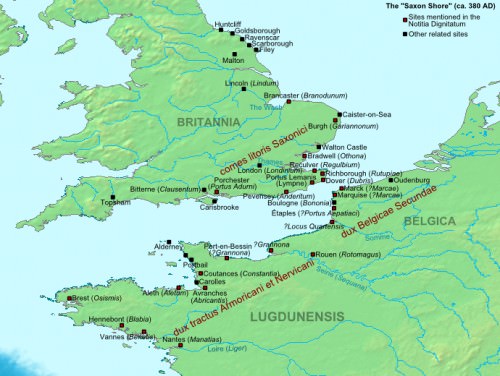
Map of the Saxon Shore, ca. 380 AD
On the continent, meanwhile, the Saxon confederacy started to break up during the 4th century CE with an increasing number of Saxons (along with other Germanic groups such as the Angles) moving into Britain, while others remained in continental Europe. Around this time, we have official Roman records attesting to more Saxon raids in southeast Britain (Ammianus Marcellinus: 26, 4). Saxon soldiers had previously been employed by the Romans as legionaires in Britain, and the conflict between Carausius and Maximian may have encouraged those who had served to leave the area around the Elbe and relocate to an independent Britain under Carausius' reign. Even after Carausius' death, however, Saxon migration to Britain continued (often characterized by writers of that time as an invasion).
THE MOVEMENT OF THE SAXONS AND THE ANGLES INTO BRITAIN WAS A CRITICAL STAGE IN THE OVERALL DEVELOPMENT OF THE ENGLISH LANGUAGE
The southeast coast of Britain was not the only place affected by Saxon incursions. Not long after the death of Emperor Constantine (337 CE), the northern frontiers of Rome in continental Europe were also suffering the incursion of several “barbarian” groups, including the Saxons. The Roman historian Zosimus offers a summary of the challenges that Constantius, the Roman emperor who came after Constantine, had to face during the 350s CE, in which the Saxons are mentioned as one of the many military threats hanging upon Rome.
But perceiving [Constantius] all the Roman territories to be infested by the incursions of the Barbarians, and that the Franks, the Alemanni, and the Saxons had not only possessed themselves of forty cities near the Rhine, but had likewise ruined and destroyed them, by carrying off an immense number of the inhabitants, and a proportionate quantity of spoils; [...] he scarcely thought himself capable of managing affairs at this critical period (Zosimus: Book 3, 1).
ANCIENT ACCOUNTS ON THE SAXON MIGRATIONS
Early in the 5th century CE, Roman control in Britain was waning, and most of Rome's military resources were allocated to the struggles in continental Europe. The Roman army withdrew from Britain completely in 410 CE, and the occupied land was left in the hands of the Romanized Britons. The territory was divided into several small warring groups, both indigenous and invaders, fighting for political control. In the midst of this social and political strife, more Saxons migrated into Britain, expanding their territory and establishing a number of kingdoms which can be identified by the fact that most of their names contain the suffix "sex" (eg Sussex, Wessex).
Ancient sources provide different versions of how exactly the Saxons arrived in Britain and how they expanded. Three major works concerned with the Saxons in Britain have survived to the present day: the De Excidio Britanniae, written by Gildas ;the Historia Ecclesiastica, by Bede and the Anglo-Saxon Chronicle, a narrative with multiple authors. According to Bede, the famous British monk who lived in the early Middle Ages, the Britons were suffering attacks from the Scots and the Picts, so they decided to hire some of the Saxons as mercenaries to fight their enemies. After completing their task, the Saxons turned against the Britons. Gildas, a 6th century CE British monk, describes the Saxons as savages similar to dogs and lions, and he adds that "nothing more destructive, nothing more bitter has ever befallen the land". Gildas saw the destructive advance of the Saxons as a form of punishment inflicted by God for the sins of the British, whom he compares with the Israelites of the Bible :
The people of the Angles or Saxons were conveyed to Britain in three long-ships. When their voyage proved a success, news of them was carried back home. A stronger army set out which, joined to the earlier ones, first of all drove away the enemy they were seeking [the Picts and Scots]. Then they turned their arms on their allies [the Britons], and subjugated almost the whole island by fire or sword, from the eastern shore as far as the western one on the trumped-up excuse that the Britons had given them a less than adequate stipend for their military services (The Greater Chronicle, cited by Higham and Ryan).
In the Anglo-Saxon Chronicle we read about the Saxons moving into Britain as successive "arrivals" by sea, under different leaders, and establishing small kingdoms in different areas of Britain: Hengest in 449 CE, leading a force of three ships, ruling over Kent; Ælle in 477 CE, leading a force of three ships, ruling over Sussex; and Cerdic, the founding figure of the West Saxon dynasty, leading a squadron of five ships and arriving in Britain in 495 CE.
Cerdic is the most famous of the Saxon kings, reigning from 519-534 CE. The Anglo-Saxon Chronicle' s entry for 519 CE states: "In this year Cerdic and Cynric obtained the kingdom of the West Saxons, and the same year they fought against the Britons at a place now called Cerdices-ford. And from that day on the princes of the West Saxons have reigned." He is said to have fought "the renowned King Arthur " in 520 CE, but that date may actually be off by one year, and the battle with Arthur took place in 519 CE. Historian Robert J. Sewell notes that, "Cerdic met great resistance from the last of the Romano-Britons under a shadowy leader who lays as good a claim as any to having been the 'real' King Arthur" (3). Cerdic either won the battle or declared a truce and was given the land by the Briton king identified with Arthur but, either way, he founded the kingdom of the West Saxons, Wessex, in Britain. While the date of 519 CE is cited in the Anglo-Saxon Chronicles for the beginning of his reign, a date as late as 532 CE is suggested by other sources. In 530 CE, Cerdic conquered the Isle of Wight, employing his already established army and navy; he died two years later in 534 CE. The earlier date, then, makes more sense than the later one in the narrative of Cerdic's life. The chaotic nature of the time, and conflicting accounts from different sources, quite often create very different narratives which have been followed, or combined, by later writers.
INTERPRETATION OF THE ANCIENT SOURCES
In the past, these traditional accounts were taken at face value, with writers rejecting one narrative in favor of another or combining two or more. Victorian writers accepted the "arrival" stories reported in the Anglo-Saxon Chronicle as historical truth, which they then modified to fit their own narrative ends. Because these older narratives often contradicted each other, later writers tried to blend them into seamless stories which provided them with a linear history of their past. This is how one may today read two very different accounts of the history of Britain which both claim to be the truth and both of which can point to older narratives for support of that claim. One must keep in mind the different versions and interpretations of the so-called "Saxon Invasions" when reading these various sources.
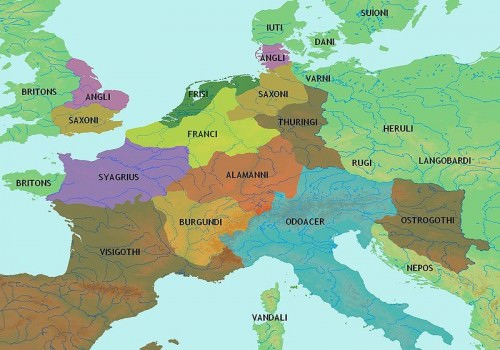
Central Europe 5th century CE
An example of this problem is the claim that the Saxons were hired by the Romans to fight in Britain. Since Rome at the time lacked troops in Britain, the account of the Saxons employed as mercenaries seems plausible: the Romanised Britons decided to hire barbarians as mercenaries for security reasons, which was a common Roman practice. Rather than reflecting mass migration, archaeological evidence of Saxon presence before 450 CE is very weak, which is consistent with the military conquest stated in the ancient accounts: as field army of the Britons, the number of Saxons could not have been initially more than a few thousand. The Gallic Chronicle of 452 CE, talks about the Saxons ruling over a large part of Southern Britain, also consistent with the rise of the number of Saxon archaeological material after 450 CE.
The earliest Anglo-Saxon burial in Britain has been dated by archaeologists to no later than 425-450 CE. The burial practices of the Saxons (and the Germanic tribes in general) were markedly different from indigenous burials in Britain. North German cremation ritual was introduced into eastern England, but Germanic people gradually abandoned cremation in favour of inhumation, burying their dead with grave goods, a custom that was in place until about 700 CE; by the late 6th century CE, furnished inhumation dominates the Saxon disposal of the dead. Saxon burials did not develop from past indigenous practices;instead, they are connected to burials found on the other side of the North Sea. Late Roman burials in Britain had been largely unfurnished inhumations but, by the late 4th century CE, we see the emergence of inhumations accompanied by weapons and belt fittings, often interpreted as the burials of Germanic mercenary soldiers, resembling other burials found in northern Gaul and other areas occupied by Germanic tribes. These burials relate to the development of Angle and Saxon burial rites detected between the 5th and 7th centuries CE: inhumation burials where men were usually buried with weapons, while women were buried with combs, brooches, and necklaces.
It is clear both from historical sources and archaeological data that by the end of the 5th century CE, southeast Britain was under the control of various Saxon groups. The spread of Saxon burial practices over places where only indigenous burials were previously recorded reflects the spread of the Saxons displacing indigenous Roman and Celtic groups.
FRANKISH ABSORPTION, CONQUEST OF ENGLAND, & CULTURAL LEGACY
During the 5th century CE, there are recorded hostilities between the Franks and the Saxons in continental Europe. Under the leadership of Childeric, the Franks supported Roman forces and helped them defeat a number of enemies including an army of Saxons at Angers in 469 CE. The Franks began a gradual process of absorption of the continental Saxons and, while this process was still ongoing during the 8th century CE, those Saxons who migrated into Britain managed to build a solid presence. After several generations of conquest, alliances, and unstable successions, they established their rule over most of the indigenous groups. After the 9th century CE Viking invasions, the kings of Wessex (Alfred and his descendants) created the first strong West Saxon kingdom (south of the Thames) which, during the 10th century CE, managed to conquer the rest of England creating the late Anglo-Saxon kingdom.

Britain, c. 600 CE
Britain was the only place in Europe that saw the formation of new states that had little in common with Roman principles. All nascent states in continental Europe that emerged after the decline of the Roman order were created on Roman foundations, sometimes with a clear Roman involvement or even retaining key aspects of Roman life. This was not the case with the Saxons who entered Britain and who were less familiar with the Roman ways.
The movement of the Saxons and the Angles into Britain was a critical stage in the overall development of the English language. If these Germanic tribes did not move into Britain, the English language as we know it would not exist today, and the dialects of the Angles and Saxons would have been gradually dissolved in the continental Germanic languages, possibly blended into the Low German and Dutch dialects. As they expanded across Britain, these Germanic groups displaced the local Celtic speaking communities. Old English, the language born of the Angles and the Saxons who entered Britain, gradually displaced the Latin and Brittonic languages across lowland Britain, and from there it eventually gained ascendency over most of the British Isles.
LICENSE:
Article based on information obtained from these sources:with permission from the Website Ancient History Encyclopedia
Content is available under License Creative Commons: Attribution-NonCommercial-ShareAlike 3.0 Unported. CC-BY-NC-SA License